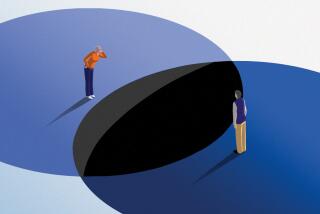Cosmic Joy & Local Pain: MUSINGS OF A MYSTIC SCIENTIST by Harold J. Morowitz (Scribner’s: $17.95; 304 pp.)
- Share via
In the last few centuries, science has been extraordinarily successful at learning about nature and discovering its structure. A wide variety of disciplines--physics, chemistry, biology and geology, to name a few--have put together an orderly and coherent picture of how the universe and the world are exquisitely put together to make everything we know and love.
In fact, if only a few details were different, the universe might not exist at all, and if a few more small details were different, there would be no life on Earth to undertake the study of science or to write or read these words.
For example, ordinary water has many unusual properties without which life could not exist. Unlike most substances, which contract on being cooled, when water turns to ice, it expands. As a result, when a lake freezes, ice, which is lighter than water, forms a layer at the top, and the water below it remains liquid. This enables living creatures in the water to remain alive.
If ice behaved like almost all other substances, it would be more dense than water and would sink to the bottom, and the lake would be frozen solid, killing all the life in it.
There are many, many such examples of properties of nature without which life could not exist, as Harold J. Morowitz, a biochemist and molecular biophysicist at Yale University, tells us in his book, “Cosmic Joy & Local Pain.” From this he concludes that the universe and everything in it could not have been formed by chance but rather is the work of some design and, presumably, designer.
“As we study the complex and interrelated aspects of planetary life, are we simply to attribute it all to random events, or are we to seek deep meanings about ourselves and the cosmos?” he asks. “Is there some meaning in all of this great array of form or is blind chance behind the richness and beauty of existence?”
Morowitz’s view--a minority view among contemporary scientists--is that chance is not enough to explain the perfect fit of nature in details large and small. “I find it hard not to see design in a universe that works so well,” he says. “Each new scientific discovery seems to reinforce that vision of design.”
Morowitz’s book is the most recent example of what is called in philosophical literature, the argument from design, which says that if there is something so well designed, it must have had a designer. Normally this designer is called God, though Morowitz prefers god. Whether the word is capitalized or not, it means the same thing. Some intelligence, some life force, some vital principle, planned the whole kit-and-caboodle.
Unfortunately, despite Morowitz’s assertions, this conclusion does not follow from the premises as inexorably as night follows day. In fact, he doesn’t really prove his argument at all. He just asserts it over and over again, as if repeating the conclusion will make up for its weakness.
“For this planet,” he writes, “life processes are part of the regulatory mechanisms that maintain all of nature in a self-sustaining manner. If that isn’t design, I don’t know what is.” He’s wrong on both counts. That isn’t design, and Morowitz doesn’t know what design is.
But let’s be fair. Some people like Morowitz and his hero, the philosopher Pierre Teilhard de Chardin, will look at science fitting together so nicely and conclude there must have been a designer. Others will look at the same set of facts, and conclude no designer is implied or required. It’s just that if things hadn’t fit together so well, there would be no universe and no life, and no one would be asking these questions.
This argument--like so many fundamental philosophical questions--is beyond the ability of reason to resolve. Those who believe in a designer cannot be persuaded there is none, and those who do not cannot be persuaded that there is.
Which side one chooses depends not on reason but on something else, something in the pre-reptilian part of the brain. The choice comes first, and the reasons are put together afterward. Reasons are the rationalizations we adopt after we have already decided what we think.
Morowitz’s book is a good, one-volume synthesis of contemporary scientific knowledge, but it does not prove that there is a God or a god or a designer or anything else. It does not prove there is “within the workings of the universe as revealed by science a plan or cosmic intelligence that somehow had us in mind.”
Despite what he describes as his mystical musings, Morowitz does not even address a central loophole in the argument from design, namely, who designed the designer? If the answer is that God always existed, why not just say that the laws of nature always existed? If it is impossible they arose without a designer, why is it possible for the designer to have arisen without a designer?
Of course, believers will not find the last sentence persuasive, just as nonbelievers are not persuaded by the argument from design. Though it includes some of the latest findings of science, Morowitz’s book does not advance this old debate.






